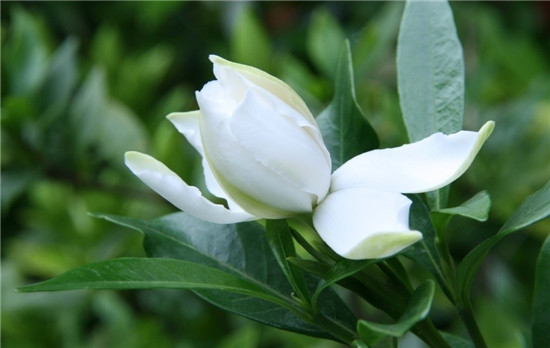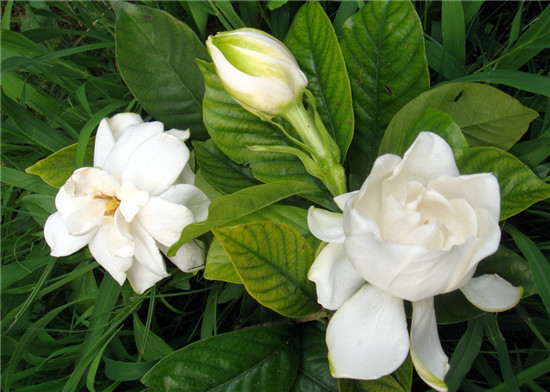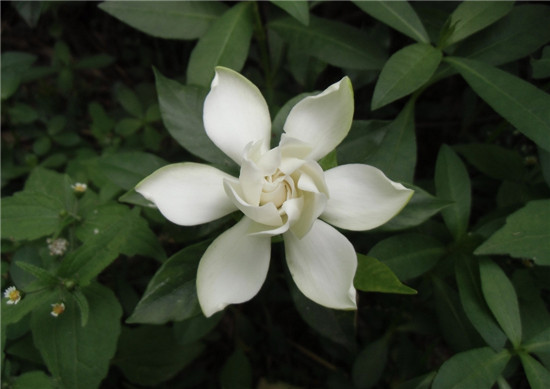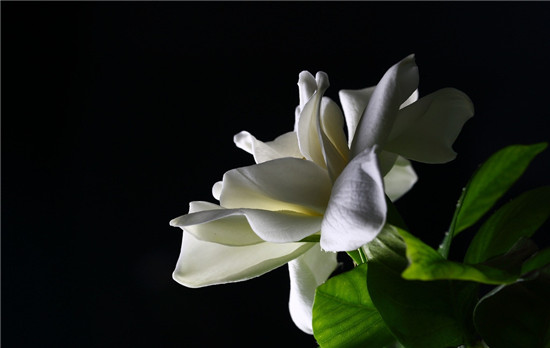The reason for the yellow leaves of gardenia
Gardenia is a familiar flower, and people like to plant it at home, so do you know why the leaves of gardenia turn yellow? Let's go and have a look.

Gardenia leaves are shaped like rabbit ears, simple, opposite or tricuspidate, glossy and entire. The flower is generally in the form of a flower growing at the top of the branch or leaf axil, white with a strong fragrance, Corolla high-footed dish-shaped, used to be called Nizi flower, and later Ni as "Zhi". Gardenia is an indicator plant of acidic soil, so whether the environment of the soil is slightly acidic or not determines the growth of gardenia. The cultivated soil should be mixed with slightly acidic sandy red soil and mixed decaying leaves at the proportion of 7:3, and the best pH value of the soil should be controlled between 4.06.5 and 4.06.5. This is not only the basic condition to avoid the yellow leaves of gardenia, but also a good guarantee.
In addition, the phenomenon of yellow leaves of gardenia can be divided into six situations: water yellow, dry yellow, burning yellow, lack of light yellow, fat yellow, lack of fat yellow. First of all, let's introduce water yellow and dry yellow. The performance of water yellow is that the young leaves are dark yellow without luster, but the old leaves have no obvious change, their branches are small yellow and green, and the new shoots do not grow all the time. This phenomenon shows that there is too much watering. At this time, the solution is to take the flowers out of the pot and put them in a ventilated and cool place and then put them back into the basin. The performance of dry and yellow is that the tip or edge of the leaf is dry, and the old leaf is withered and yellow from the bottom up, but the growth of the new leaf is relatively normal, so as long as you pay attention to watering it thoroughly.

Gardenia grows like one in the four seasons, the leaf color is evergreen, the fragrance is elegant when blooming, and the white flowers are white, which is particularly beautiful and very attractive. It is often used for potted plants in courtyards, balconies and other places. It has strong environmental adaptability, can grow well in these places, and has strong decorative and ornamental effects. Below, I will talk about the cultivation methods of gardenia from the various characteristics of gardenia.
First, sour soil culture, gardenia need scattered light, so like sour soil, if the soil is alkaline, it will make gardenia can not absorb iron very well, which has a great impact on the formation of chlorophyll, and further cause flower branches to wither and even die; so the soil must use loose, fertile acid soil, you can also add some substances with such effect.
Second, put in a cool place, gardenia must not be exposed to the scorching sun, otherwise the leaves will be withered and yellow, but it does not mean that it should be put in the whole shade, because it has a certain demand for light, it is best to keep 60% of the light every day, in addition, after entering April, fertilizing should be carried out twice a month.

Third, the air humidity, gardenia like to be wet, so the air can not be too dry, according to expert statistics, if the air humidity is less than 70%, it will affect the normal opening of flowers, but if it is too wet, it will cause rotting roots and yellow leaves, so in addition to normal watering, we should often spray clean water nearby. Another problem we should pay great attention to is that water should not be watered too much, otherwise it will also affect growth. So how to water gardenia? When you see the soil dry, knock on the flowerpot with your hand. if there is an empty sound, you need to water it. The bottom of the flowerpot starts to leak and stops. It is better to add some eggs and soy milk to the water, which is more conducive to growth.
Fourth, fertilization tips, gardenia like fertilizer, but can not add too much fertilizer at one time, must be thin fertilizer, must not save trouble, otherwise it will cause thick branches, big leaves, thick green, it will lose its own appreciation effect.
Fifth, temperature requirements, the growth temperature of gardenia can not be too low, because it likes temperature, generally speaking, the temperature of the growing period is 18 to 22 degrees, 5 to 10 degrees in winter, and frostbite if it is less than 10 degrees below zero, which should be paid special attention to in the north.

Causes of yellow leaves of gardenia flower
The main results are as follows: (1) too much watering, the basin soil is too wet for a long time, resulting in lack of oxygen in the soil, causing part of the fibrous roots to rot, hindering normal respiration and absorption of water and nutrients, causing leaves to turn yellow and fall off. After the injury, the young leaves turn pale yellow, and then the old leaves gradually turn yellow. watering should be controlled immediately, fertilization should be suspended, and the soil should be often loosened to make the soil well ventilated.
(2) drought and dehydration. Flower cultivation leakage watering or long-term watering half waist water (that is, upper wet and lower dry) will affect nutrient absorption, and it is also easy to cause dull and dull leaves and drooping leaves. First, the lower old leaves aged, and gradually withered and yellowed off from the bottom up. At this time, a small amount of water is needed and sprayed, so that it can be gradually recovered and then transferred to normal watering.
(3) to lose weight for a long time. There is no application of ammonia fertilizer or no change of soil for a long time, and there is a lack of nitrogen and other nutrients in the soil, resulting in thin branches and leaves and thin and yellow leaves. It is necessary to pour the pot in time and gradually apply rarefied mature liquid fertilizer or compound flower fertilizer into new loose and fertile culture soil.
(4) excessive fertilization. If you fertilize too much, the new leaves will be thick and uneven, and the dry tips of the old leaves will fall off. You should immediately stop fertilization and increase the amount of water to make the fertilizer flow out from the drainage hole at the bottom of the basin, or immediately pour the pot, rinse the soil block with water and then plant it again into the basin.
(5) hot and high temperature. In summer, if you put cool flowers (such as cyclamen, Golden Bell upside down, four Seasons Begonia) in a high temperature place to let the strong light shine directly, it is very easy to cause the young leaf tip and leaf edge to scorch, or the leaf yellow to fall off. Move to a well-ventilated shady place in time.
(6) excessive shading. If the sun-loving flowers are kept in shade or lack of light for a long time, it will cause the branches and leaves to grow, the leaves are thin and yellow, and they do not blossom or rarely bloom. Be careful to move the flowerpot to the sunny place.
(7) soil and water deviation. There are more saline and alkali in soil and water in most areas of northern China, and flowers with acid-like soil are planted, such as rhododendron, camellia, Michelia, gardenia, orchid, magnolia, sweet-scented osmanthus and so on. Due to the lack of soluble iron and other elements that can be absorbed by the soil, the leaves will gradually turn yellow. Acid soil should be selected when planting, and alum fertilizer and water should be often watered during the growth period.
(8) whether it is airtight or not. If too much nitrogen fertilizer is applied, the branches and leaves will grow luxuriantly, coupled with the long-term unpruned, resulting in insufficient light in the inner chamber branches and leaves, which is easy to cause the leaves to yellowing and falling off. Reasonable fertilization should be applied and pruning should be strengthened to make it ventilated and transparent.
These are all the reasons for the yellowing of gardenia leaves that I have summarized for you. I hope this article can help you. Please continue to follow us.
Suspend fertilization and often loosen the soil to make the soil well ventilated.
(2) drought and dehydration. Flower cultivation leakage watering or long-term watering half waist water (that is, upper wet and lower dry) will affect nutrient absorption, and it is also easy to cause dull and dull leaves and drooping leaves. First, the lower old leaves aged, and gradually withered and yellowed off from the bottom up. At this time, a small amount of water is needed and sprayed, so that it can be gradually recovered and then transferred to normal watering.
(3) to lose weight for a long time. There is no application of ammonia fertilizer or no change of soil for a long time, and there is a lack of nitrogen and other nutrients in the soil, resulting in thin branches and leaves and thin and yellow leaves. It is necessary to pour the pot in time and gradually apply rarefied mature liquid fertilizer or compound flower fertilizer into new loose and fertile culture soil.
(4) excessive fertilization. If you fertilize too much, the new leaves will be thick and uneven, and the dry tips of the old leaves will fall off. You should immediately stop fertilization and increase the amount of water to make the fertilizer flow out from the drainage hole at the bottom of the basin, or immediately pour the pot, rinse the soil block with water and then plant it again into the basin.
(5) hot and high temperature. In summer, if you put cool flowers (such as cyclamen, Golden Bell upside down, four Seasons Begonia) in a high temperature place to let the strong light shine directly, it is very easy to cause the young leaf tip and leaf edge to scorch, or the leaf yellow to fall off. Move to a well-ventilated shady place in time.
(6) excessive shading. If the sun-loving flowers are kept in shade or lack of light for a long time, it will cause the branches and leaves to grow, the leaves are thin and yellow, and they do not blossom or rarely bloom. Be careful to move the flowerpot to the sunny place.
(7) soil and water deviation. There are more saline and alkali in soil and water in most areas of northern China, and flowers with acid-like soil are planted, such as rhododendron, camellia, Michelia, gardenia, orchid, magnolia, sweet-scented osmanthus and so on. Due to the lack of soluble iron and other elements that can be absorbed by the soil, the leaves will gradually turn yellow. Acid soil should be selected when planting, and alum fertilizer and water should be often watered during the growth period.
(8) whether it is airtight or not. If too much nitrogen fertilizer is applied, the branches and leaves will grow luxuriantly, coupled with the long-term unpruned, resulting in insufficient light in the inner chamber branches and leaves, which is easy to cause the leaves to yellowing and falling off. Reasonable fertilization should be applied and pruning should be strengthened to make it ventilated and transparent.
These are all the reasons for the yellowing of gardenia leaves that I have summarized for you. I hope this article can help you. Please continue to follow us.
Related
- Wuhan Hospital Iron Tree Blooming Result Was Instantly Frightened by the Gardener Master
- Which variety of camellia is the most fragrant and best? Which one do you like best?
- What is the small blue coat, the breeding methods and matters needing attention of the succulent plant
- Dormancy time and maintenance management of succulent plants during dormancy
- Minas succulent how to raise, Minas succulent plant pictures
- What are the varieties of winter succulent plants
- How to raise succulent plants in twelve rolls? let's take a look at some experience of breeding twelve rolls.
- Attention should be paid to water control for succulent plants during dormant period (winter and summer)
- Watering experience of twelve rolls of succulent plants
- Techniques for fertilizing succulent plants. An article will let you know how to fertilize succulent plants.



